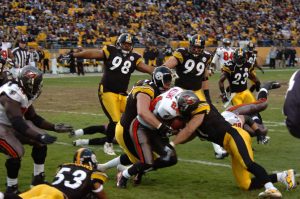The NHL offseason should be red hot or about to wrap. Instead, nearly two weeks after the free agent frenzy, teams have big name restricted free agents adrift in a sea of confusion and frustration. Like many other teams, the Pittsburgh Penguins have several RFAs but not enough money to go around.
In years past, teams with salary cap space would accept an asset and a contract and teams without cap space would pay the price. Everybody won as the tight-cap team gained salary cap room and the lesser team got a little better.
That hasn’t worked out this offseason.
This summer, the teams with salary cap space have demanded more. Perhaps it is because of the parity in the league, watching underfunded teams like the Arizona Coyotes stay in playoff contention, or supply and demand, but the trades to free salary have not happened.
There is a logjam of RFAs waiting for contracts because of it. And there are a few UFAs who are beginning to wonder if they’ll ever find a home. The Jake Gardiner market has reportedly been dry.
The Pittsburgh Penguins realistically have about $2.3 million of cap space. That is enough to sign only one of their restricted free agents. As we saw at the 2019 NHL Draft last month, teams with cap space drove hard bargains. And not much happened.
The big blockbusters everyone expected before Friday night fizzled and the draft became a three-hour fishing show.
The hotly rumored New York Islanders offer sheet for the Toronto Maple Leafs RFA Mitch Marner has not yet materialized. The National Hockey Now family had a source within the Islanders organization who thought it was coming last weekend. It didn’t. Others outlets strongly hinted at it. But a week later and…nothing.
So Marner remains unsigned. So do Patrick Laine and Kyle Connor of the Winnipeg Jets. Jacob Trouba, who was acquired by the New York Rangers for well below market value also remains unsigned.

And that’s the problem–teams with RFAs and little cap space have been unwilling to lose trades to free up space and teams with space are demanding red-tag clearance sale prices.
There is growing frustration with the process, too. Players and their camps are wondering when things will move. Players expected to be signed by now or at least have a better understanding of the market.
But nothing is happening. It is July 12, and there are a few dozen RFAs left unsigned. As one agent said to PHN last week, “You probably know more than me.”
Not even Patrick Marleau and Joe Thornton have re-upped in San Jose yet. Absolutely.nothing.is.happening. The NHL logjam seems to have no end in sight, either. As teams and players go to Arbitration beginning next week, there will be some movement. The Penguins will know what they must pay Zach Aston-Reese or relinquish his rights.
But Marcus Pettersson and Teddy Blueger must continue to negotiate.
The St. Louis Blues will finally know what their Stanley Cup-winning goalie Jordan Binnington is worth. A few other big names who will set the market are also set to battle their teams for a contract.
But more are not eligible. And the money to sign those RFAs is being held by teams like Ottawa, who are currently under the salary cap floor but in no hurry to make a move. Organizations such as Ottawa, New Jersey, Carolina and LA have some money to spend but haven’t been given proper motivation.
When Montreal offered Sebastian Aho an offer sheet, it was the first time an offer sheet was signed since 2013. We could see more out of the box thinking later this month. The NHL buyout window closed on June 30. However, there is a second buyout window for teams who have one or more arbitration cases.
That second window begins on the third day after the case is settled or the arbitration-eligible player signs a contract. The window lasts for only 48 hours. And another catch is the buy-out player must make over $3.4 million.

Could we see teams swallow their medicine and buyout a serviceable, productive player?
A situation like this has not occurred in recent memory, and no one is quite sure what is going to happen. Certainly not the players who are waiting, and hoping. Perhaps not even the teams know because they never expected the situation to get like this.
Of course, the situation is the fault of good teams stockpiling piling players to chase the Stanley Cup. Does anyone want to see that stop? Until now, there were always safety options and ways around being stuck at the cap ceiling. But as the salary cap fell from the expected $83 million to only $81.5 to alleviate the unpopular escrow issue, teams were caught shorthanded.
With an extra $1.5 million, the Penguins would likely have at least one, if not two of their RFAs under contract. GM Jim Rutherford could easily fit Pettersson and Aston-Reese on the roster with $3.8 million and likely do a little more tinkering for the space to sign Blueger.
But other teams are in the same crunch. And right now, the chatter has become the sounds of silence. The NHL offseason drama is not over. Consider this the calm before the next storm.











